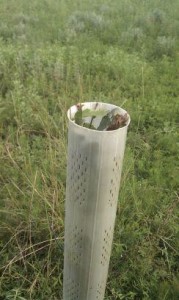Not so long ago most tree tube companies, when attempting to explain when to use tree tubes of various sizes, resorted to language along these lines: “Moderate deer browse – 4ft”, “Heavy deer browse – 5ft”, “Extreme deer browse – 6ft”.
A pretty dopey way of stating things! (And I was as guilty as anyone.) What the heck is “moderate” deer browse? And how would one know for sure before even planting the trees the level of deer browse to expect?
More recently I have adapted (what I hope is) a more commonsensical approach to explaining what height of tree tube is best, focusing on cost/benefit and risk.
75% of the time 4ft tree tubes provide enough browse protection to successfully establish a tree. That means that 25% of the time, deer will keep trees emerging from 4ft tubes clipped off at that height and will not allow them to grow taller. Supplemental methods must be used to get the trees above that last foot or so past the browse line – either a “tube extender” or an effective deer repellent.
What are the risk factors that increase the likelihood that your trees will fall into the 25% category? Location – proximity to the woods, a waterway, or another well-traveled deer area. Species – fruit trees in particular tend to get browsed more heavily than other species. Local deer density – The more deer per square mile (two good indicators of this are 1) frequently seeing herds of 6 or more deer in the evenings or morning, and 2) high numbers of deer hit by cars in the area – kind of morbid I know but it’s an accurate gauge of local deer density).
90% of the time 5ft tree tubes provide enough protection.
100% of the time 6ft tree tubes do the job.
Here’s a great example that illustrates all of this, sent to me by a customer:
He planted sawtooth oak and Chinese chestnut. In the vast majority of cases the 4ft tubes have provided more than enough protection and the trees have grown safely past the browse line.
However, as you can see from the photo, a small number of trees have been clipped right at the rim of the tube and not allowed to grow taller. This has only occurred in parts of his property adjacent to woodlands where deer densities tend to be higher.
So much of forestry is about trade offs. A trade off faced by many tree planters today is: “Given my budget I can either protect more trees with 4ft tubes, knowing that I might need to provide supplemental protection for some of those trees later, or fewer trees with 5ft tubes and be pretty much assured that I won’t have to provide additional protection (or I could use even fewer 6ft tubes and not worry about the trees at all!).”
This year in particular I am seeing much more sophistication in the way folks are ordering tree tubes. I am seeing tons of orders where the customer is buying some 4ft and some 5ft tubes. I absolutely LOVE to see orders like this, because I know that the customer has given the project a lot of thought, and made decisions about which tube is best based on the risk factors. “I’ll put my sawtooth oak in 4ft tubes, but my crab apple and persimmon in 5ft tubes. I’ll use 4ft tubes out in the middle of the field, but 5ft tubes along the edge of the forest where deer tend to congregate. I’ll use 4ft tubes on the knobs and ridges, but 5ft or even 6ft tubes along the draws and creeks.”
To me these “split” orders of 4ft and 5ft tubes are another sign of the increasing number of people who “get it” – who understand tree tubes and how to use them to their best advantage. And it’s another reason why I have never had more fun selling tree tubes in my 25 year career than I am having now: My customers are smarter than ever, and their results show it!

